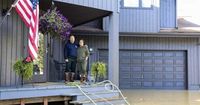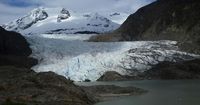On August 13, 2025, Juneau, Alaska’s capital city, braced itself for the worst as the Mendenhall River surged to a record-breaking crest of 16.65 feet, threatening hundreds of homes and prompting citywide evacuations. The culprit? A glacial outburst flood, triggered by the sudden release of rainwater and snowmelt from Suicide Basin, dammed by the mighty Mendenhall Glacier. But in a dramatic turn, newly installed flood barriers—controversial, costly, and only meant to last a decade—held the line, sparing the city from the catastrophic losses seen in previous years.
According to USA TODAY, most of Juneau’s 32,000 residents live in the vulnerable Mendenhall Valley, a region that’s faced the brunt of glacial flooding for several years running. This summer, the city installed two miles of HESCO barriers—large, sandbag-style levees—along the river in a bid to outsmart the increasingly unpredictable summer floods. The decision, as noted by city officials and reported by outlets like KTOO and the Santa Fe New Mexican, was not without controversy. Some residents questioned the project’s price tag and demanded a more permanent fix. Others, like Locke and Melissa Brown, whose home has flooded three years in a row, saw the barriers as a lifeline. "If they weren’t here, it would have been catastrophic for us," Locke Brown told KTOO, echoing the relief felt by many in the community.
Yet the barriers weren’t perfect. Water managed to seep through in some spots, flooding several streets including Meander Way, Meadow Lane, and Northland Street. On Meander Way, Sean Smack ferried diesel jugs to neighbors by raft so they could power generators and pump out water after the city cut electricity as the river rose. "The Meander Way water taxi service — once a year, have no fear," Smack joked to KTOO, capturing a moment of levity amid the tension. The Browns, meanwhile, watched water from their crawl space snake through a garden hose and down their porch steps. "We’re going to be doing this for five years in total, and then we’re forced to move on military orders," Locke said, referencing his wife Melissa’s Coast Guard service. "How are we going to sell our house?"
For others, the outcome was a welcome change. Andrew Hills, whose house had been hit by floods last year, walked Northland Street with his toddler on his shoulders and told KTOO, "This is awesome. I could not be happier. I feel terrible for the people at the end of Meander, but, you know, really happy it didn’t hit us." He’d spent the night monitoring the barriers, watching as they leaked but ultimately held.
Juneau City Manager Katie Koester summed up the city’s sentiment at a Wednesday morning press conference: "I know we’re not entirely out of the woods, but the HESCO barriers really have protected our community. If it weren’t for them, we would have hundreds and hundreds of flooded homes." As the Santa Fe New Mexican also reported, Koester acknowledged the barriers are a temporary fix, meant to last about a decade, and their performance in even higher floods remains uncertain. The city doesn’t yet know if the barriers could withstand a crest above 18 feet—a real possibility, given that this year’s record was more than half a foot higher than last year, which itself had set a new high-water mark.
Experts from the National Weather Service in Juneau noted the significance of this year’s event. Nicole Ferrin, the warning coordination meteorologist, told KTOO, "This is a new all-time record-high crest for the Mendenhall Lake and river system." The crest arrived earlier than forecast, with Aaron Jacobs, the agency’s senior service hydrologist, explaining that rainfall in the preceding days had masked the telltale signal of Suicide Basin’s release. "It really hides the signal that we would be looking for if water was coming from Suicide Basin," Jacobs said. In the end, it appears the release began sometime on Monday morning, catching some off guard.
Despite the success of the barriers, the flood did leave its mark. Water pooled in yards and homes, and the current swept away trees from the riverbank, with one crushing a section of the HESCO barrier. The city quickly reinforced the damaged spot with massive sandbags, known as supersacks. Back Loop Bridge sustained damage from tree strikes and erosion, forcing its closure. "We are beginning to lose portions of the road associated with that abutment there, and that’s the main support where we have piles that go into the ground that hold up the bridge sections themselves," said Christopher Goins with the Alaska Department of Transportation, according to KTOO. Repairs are expected to restore the bridge’s integrity.
Evacuations went smoothly, with many residents leaving ahead of the flood’s peak. Only seven people spent the night at the city’s emergency shelter on the Floyd Dryden campus. Shari Weimer, one of the evacuees, explained her decision to KTOO: "I’m right one street over from the river, and I just chose to evacuate because my life is worth more than home." Her house had flooded the past two years, and with this year’s higher crest and concerns about the temporary levee, she wasn’t willing to risk it again.
Emergency responders, led by Capital City Fire/Rescue Assistant Chief Sam Russell, reported that no rescues were needed overnight—a testament to the city’s preparation and the barriers’ effectiveness. As floodwaters receded by late afternoon, officials reopened affected areas, but urged residents to stay out of flooded zones until an "all clear" alert was issued. The Juneau School District postponed the first day of school from August 14 to August 15 to allow the area more time to dry out.
While the immediate danger has passed, the events of August 13 have reignited debate over Juneau’s flood defenses. The barriers worked, but their temporary nature and rising flood records raise tough questions about the city’s long-term future. As climate change continues to drive glacial melt and unpredictable weather, Juneau’s experience stands as both a warning and a lesson in adaptation, resilience, and the challenges of protecting a community perched on the edge of a changing world.

